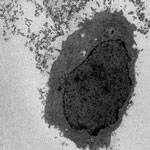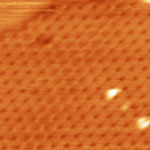Showing Spotlights 129 - 136 of 213 in category All (newest first):
 Quick Response Codes, or QR codes for short, are two-dimensional matrix codes that can hold 100 times more data than a traditional barcode. QR codes have rapidly gained popularity and are now very commonly used in various products, because of fast readability and large storage capacity. Applying the concept of QR codes to security printing applications - think banknotes - researchers have now developed an invisible QR code made from nanoparticles. They applied upconverting inks to print QR codes on paper and transparent tape, using an aerosol jet direct writing machine. They produced QR codes with embedded security characters using blue and green upconverting inks. These codes are invisible to the naked eye but produce single- and multi-color upconversion luminescence images under near-infrared excitation which can be read and decoded with an unmodified smart phone.
Quick Response Codes, or QR codes for short, are two-dimensional matrix codes that can hold 100 times more data than a traditional barcode. QR codes have rapidly gained popularity and are now very commonly used in various products, because of fast readability and large storage capacity. Applying the concept of QR codes to security printing applications - think banknotes - researchers have now developed an invisible QR code made from nanoparticles. They applied upconverting inks to print QR codes on paper and transparent tape, using an aerosol jet direct writing machine. They produced QR codes with embedded security characters using blue and green upconverting inks. These codes are invisible to the naked eye but produce single- and multi-color upconversion luminescence images under near-infrared excitation which can be read and decoded with an unmodified smart phone.
Oct 8th, 2012
 In the construction industry and in architecture, nanotechnology and nanomaterials provide new opportunities. 'Nano-products' for construction purposes are currently found in four main sectors: cement-bound construction materials, noise reduction and thermal insulation or temperature regulation, surface coatings to improve the functionalities of various materials, and fire protection. At the present time, nanomaterials - and therefore 'nano-products' - remain considerably more expensive than conventional alternatives due to the required production technology, and the technical performance of many products remains to be demonstrated. Also, Information on which nanomaterial is found in which form and concentration in a product is often unavailable, particularly to end users.
In the construction industry and in architecture, nanotechnology and nanomaterials provide new opportunities. 'Nano-products' for construction purposes are currently found in four main sectors: cement-bound construction materials, noise reduction and thermal insulation or temperature regulation, surface coatings to improve the functionalities of various materials, and fire protection. At the present time, nanomaterials - and therefore 'nano-products' - remain considerably more expensive than conventional alternatives due to the required production technology, and the technical performance of many products remains to be demonstrated. Also, Information on which nanomaterial is found in which form and concentration in a product is often unavailable, particularly to end users.
Sep 13th, 2012
 Aquatic ecotoxicity test methods, which are routinely applied to testing of nanomaterials, were originally developed for water soluble chemicals. Nanomaterials are fundamentally different from many 'conventional' chemicals as they often have limited or no solubility at all and are potentially released to the environment in a particulate form (e.g. carbon nanotubes). Only limited nano-specific guidance on ecotoxicity testing is currently available, for instance existing OECD ecotoxicity test guidelines to nanomaterials. These guidelines exhibit a number of specific shortcomings mainly related to characterization, exposure preparation, quantification and monitoring concentrations, and dose-metrics. A new paper from scientists in Denmark contributes to the progress in algae testing of nanomaterials. This work also aids in the development of additional guidance as it adds to the understanding of pros and cons of different techniques for biomass quantification.
Aquatic ecotoxicity test methods, which are routinely applied to testing of nanomaterials, were originally developed for water soluble chemicals. Nanomaterials are fundamentally different from many 'conventional' chemicals as they often have limited or no solubility at all and are potentially released to the environment in a particulate form (e.g. carbon nanotubes). Only limited nano-specific guidance on ecotoxicity testing is currently available, for instance existing OECD ecotoxicity test guidelines to nanomaterials. These guidelines exhibit a number of specific shortcomings mainly related to characterization, exposure preparation, quantification and monitoring concentrations, and dose-metrics. A new paper from scientists in Denmark contributes to the progress in algae testing of nanomaterials. This work also aids in the development of additional guidance as it adds to the understanding of pros and cons of different techniques for biomass quantification.
Aug 31st, 2012
 When a nanomaterial enters a physiological environment, it often adsorbs suspended biomolecules including proteins, lipids, small molecules, saccharides, and nucleic acids. These biomolecules define a new interface between the nanomaterial and its surroundings that mediates cellular association and response. In a recent article appearing in ACS Nano, Drs. Anna Salvati, Kenneth Dawson, and their colleagues at the University College in Dublin, Ireland, show that if nanoparticles are exposed directly to cells in the absence of suspended biomolecules, the nanoparticles will extract biomolecules from cells themselves. These findings suggest that in vitro toxicological or cell uptake studies performed in the absence of added serum may not be relevant in vivo.
When a nanomaterial enters a physiological environment, it often adsorbs suspended biomolecules including proteins, lipids, small molecules, saccharides, and nucleic acids. These biomolecules define a new interface between the nanomaterial and its surroundings that mediates cellular association and response. In a recent article appearing in ACS Nano, Drs. Anna Salvati, Kenneth Dawson, and their colleagues at the University College in Dublin, Ireland, show that if nanoparticles are exposed directly to cells in the absence of suspended biomolecules, the nanoparticles will extract biomolecules from cells themselves. These findings suggest that in vitro toxicological or cell uptake studies performed in the absence of added serum may not be relevant in vivo.
Jul 24th, 2012
 Nanotechnology is increasingly being researched for applications in the construction industry and cement is a particular focus. Apart from reducing the damaging environmental side effects of cement production, another research focus is on reinforcing concrete to improve its mechanical performance. When researchers think of nanomaterial reinforcements for concrete, carbon nanotubes come as first option. The problem with carbon nanotubes is that they are water insoluble. In order to make them compatible with water chemistry, they must be functionalized in advance. To get around this problem, a team of scientists have proposed inorganic oxide nanotubes as natural means of reinforcements of cement pastes, in view of their chemically compatibility with the cement-water system.
Nanotechnology is increasingly being researched for applications in the construction industry and cement is a particular focus. Apart from reducing the damaging environmental side effects of cement production, another research focus is on reinforcing concrete to improve its mechanical performance. When researchers think of nanomaterial reinforcements for concrete, carbon nanotubes come as first option. The problem with carbon nanotubes is that they are water insoluble. In order to make them compatible with water chemistry, they must be functionalized in advance. To get around this problem, a team of scientists have proposed inorganic oxide nanotubes as natural means of reinforcements of cement pastes, in view of their chemically compatibility with the cement-water system.
Jun 12th, 2012
 An international group of researchers reported a new record long distance for quantum teleportation. The authors claim a free-space distance of 143 kilometers. Quantum teleportation communicates physical information soundly without traveling directly through the space connecting the communicating parties. The reporting team includes quantum teleportation pioneer Anton Zeilinger of the Quantum Optics, Quantum Nanophysics, Quantum Information at the University of Vienna. Quantum teleportation combines classical and quantum information channels to transmit the complex state of quantum particles. The communication method conveys complete quantum information without the need to pass directly through the space between communicating parties.
An international group of researchers reported a new record long distance for quantum teleportation. The authors claim a free-space distance of 143 kilometers. Quantum teleportation communicates physical information soundly without traveling directly through the space connecting the communicating parties. The reporting team includes quantum teleportation pioneer Anton Zeilinger of the Quantum Optics, Quantum Nanophysics, Quantum Information at the University of Vienna. Quantum teleportation combines classical and quantum information channels to transmit the complex state of quantum particles. The communication method conveys complete quantum information without the need to pass directly through the space between communicating parties.
Jun 4th, 2012
 The fascination with two-dimensional (2D) materials that has started with graphene has spurred researchers to look for other 2D structures like for instance metal carbides and nitrides. One particularly interesting analogue to graphene would be 2D silicon - silicene - because it could be synthesized and processed using mature semiconductor techniques, and more easily integrated into existing electronics than graphene is currently. However, silicene does not seem to exist in nature nor is there any solid phase of silicon similar to graphite. Nevertheless, silicene has been predicted by theory as early as 1994. Researchers have now presented the first clear evidence for the synthesis and thus the existence of silicene - a two-dimensional material, with a honeycomb-like arrangement of silicon atoms.
The fascination with two-dimensional (2D) materials that has started with graphene has spurred researchers to look for other 2D structures like for instance metal carbides and nitrides. One particularly interesting analogue to graphene would be 2D silicon - silicene - because it could be synthesized and processed using mature semiconductor techniques, and more easily integrated into existing electronics than graphene is currently. However, silicene does not seem to exist in nature nor is there any solid phase of silicon similar to graphite. Nevertheless, silicene has been predicted by theory as early as 1994. Researchers have now presented the first clear evidence for the synthesis and thus the existence of silicene - a two-dimensional material, with a honeycomb-like arrangement of silicon atoms.
Mar 23rd, 2012
 Recent studies have found that nanomaterials - in this case dusts and powders having nanosize particles - exhibit an explosion severity which is not disproportionate to micrometer-sized materials, but the likelihood of explosion is quite high due to very low ignition energies and temperatures.
A recent review concludes that nanomaterials present a dust explosion hazard, with metallic nanoparticles being particularly reactive. Nanomaterials have been shown to display lower ignition energy and temperature requirements than larger particles. Due to this high sensitivity, explosion hazards may exist for many processes including, but not limited to, mixing, grinding, drilling, sanding, and cleaning.
Recent studies have found that nanomaterials - in this case dusts and powders having nanosize particles - exhibit an explosion severity which is not disproportionate to micrometer-sized materials, but the likelihood of explosion is quite high due to very low ignition energies and temperatures.
A recent review concludes that nanomaterials present a dust explosion hazard, with metallic nanoparticles being particularly reactive. Nanomaterials have been shown to display lower ignition energy and temperature requirements than larger particles. Due to this high sensitivity, explosion hazards may exist for many processes including, but not limited to, mixing, grinding, drilling, sanding, and cleaning.
Mar 20th, 2012
 Quick Response Codes, or QR codes for short, are two-dimensional matrix codes that can hold 100 times more data than a traditional barcode. QR codes have rapidly gained popularity and are now very commonly used in various products, because of fast readability and large storage capacity. Applying the concept of QR codes to security printing applications - think banknotes - researchers have now developed an invisible QR code made from nanoparticles. They applied upconverting inks to print QR codes on paper and transparent tape, using an aerosol jet direct writing machine. They produced QR codes with embedded security characters using blue and green upconverting inks. These codes are invisible to the naked eye but produce single- and multi-color upconversion luminescence images under near-infrared excitation which can be read and decoded with an unmodified smart phone.
Quick Response Codes, or QR codes for short, are two-dimensional matrix codes that can hold 100 times more data than a traditional barcode. QR codes have rapidly gained popularity and are now very commonly used in various products, because of fast readability and large storage capacity. Applying the concept of QR codes to security printing applications - think banknotes - researchers have now developed an invisible QR code made from nanoparticles. They applied upconverting inks to print QR codes on paper and transparent tape, using an aerosol jet direct writing machine. They produced QR codes with embedded security characters using blue and green upconverting inks. These codes are invisible to the naked eye but produce single- and multi-color upconversion luminescence images under near-infrared excitation which can be read and decoded with an unmodified smart phone. 
 Subscribe to our Nanotechnology Spotlight feed
Subscribe to our Nanotechnology Spotlight feed





